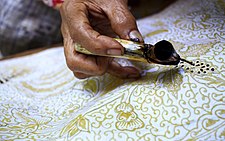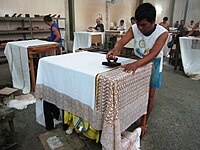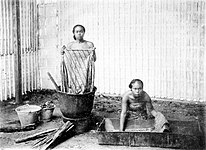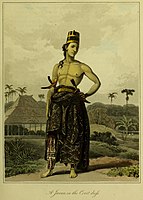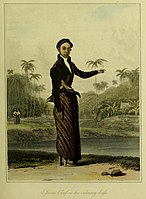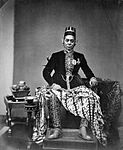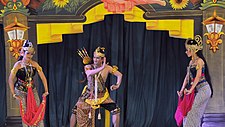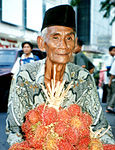
A | B | C | D | E | F | G | H | CH | I | J | K | L | M | N | O | P | Q | R | S | T | U | V | W | X | Y | Z | 0 | 1 | 2 | 3 | 4 | 5 | 6 | 7 | 8 | 9
 Batik from Surakarta in Central Java province in Indonesia; before 1997 | |
| Type | Art fabric |
|---|---|
| Material | Cambrics, silk, cotton |
| Place of origin | Indonesia[1][2][3] |
| Indonesian Batik | |
|---|---|
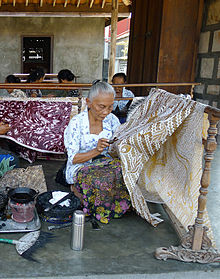 | |
| Country | Indonesia |
| Domains | Traditional craftsmanship, oral traditions and expressions, social practices, rituals and festive events |
| Reference | 00170 |
| Region | Asia and the Pacific |
| Inscription history | |
| Inscription | 2009 (4th session) |
| List | Representative |
| Written batik (batik tulis) and stamped batik (batik cap) | |
| Education and training in Indonesian Batik[a] | |
|---|---|
 | |
| Country | Indonesia |
| Domains | Traditional craftsmanship, oral traditions and expressions, social practices, rituals and festive events |
| Reference | 00318 |
| Region | Asia and the Pacific |
| Inscription history | |
| Inscription | 2009 (4th session) |
| List | Good Safeguarding Practices |
Batik[b] is an Indonesian technique of wax-resist dyeing applied to the whole cloth.[1][4][2][5][6] This technique originated from the island of Java, Indonesia.[3] Batik is made either by drawing dots and lines of wax with a spouted tool called a canting,[c] or by printing the wax with a copper stamp called a cap.[d][7] The applied wax resists dyes and therefore allows the artisan to colour selectively by soaking the cloth in one colour, removing the wax with boiling water, and repeating if multiple colours are desired.[3]
Indonesian coastal batik (batik pesisir) made in the island of Java has a history of acculturation, a mixture of native and foreign cultures.[8] It is a newer model compared to inland batik, and it uses more colors, though the patterns are less intricate. This is because inland batik used to be made by select experts living in palace areas, while coastal batik can be made by anyone.[citation needed]
Batik is very important to Indonesians and many people wear it to formal or casual events. Batik is commonly used by Indonesians in various rituals, ceremonies, traditions, celebrations, and even in daily uses.[9]
On October 2, 2009, UNESCO officially recognized the batik—written batik (batik tulis) and stamped batik (batik cap)—as a Masterpiece of Oral and Intangible Heritage of Humanity from Indonesia, and encouraged the Indonesian people and the Indonesian government to safeguard, transmit, promote, and develop the craftsmanship of batik.[1] Since then, Indonesia celebrates "the National Batik Day" (Indonesian: Hari Batik Nasional) annually on October 2. Nowadays, Indonesians wear batik in honor of this ancient tradition.[9]
In the same year, UNESCO also recognized "Education and training in Indonesian Batik intangible cultural heritage for elementary, junior, senior, vocational school and polytechnic students, in collaboration with the Batik Museum in Pekalongan" as a Masterpiece of Oral and Intangible Heritage of Humanity in the Register of Good Safeguarding Practices List.[10]
Etymology
The word batik is Javanese in origin. The word bathikan also means "drawing" or "writing" in Javanese.[11] When the word is absorbed to Indonesian, the "th-" sound is reduced to a "t-" sound more pronounceable to non-Javanese speakers.
The word batik is first recorded in English in the Encyclopædia Britannica of 1880, in which it is spelled as battik. It is attested in the Indonesian Archipelago during the Dutch colonial period in various forms such as mbatik, mbatek, batik and batek.[12][13][14] Batik known as euyeuk in Sundanese, cloth can be processed into a form of batik by a pangeyeuk (batik maker).[15]
History

Batik is an ancient fabric wax-resist dyeing tradition of Java, Indonesia.[16] The art of batik is most highly developed and some of the best batiks in the world still made there. In Java, all the materials for the process are readily available—cotton and beeswax and plants from which different vegetable dyes are made.[17] Indonesian batik predates written records: G. P. Rouffaer argues that the technique might have been introduced during the 6th or 7th century from India or Sri Lanka.[18] On the other hand, the Dutch archaeologist J.L.A. Brandes and the Indonesian archaeologist F.A. Sutjipto believe Indonesian batik is a native tradition, since several regions in Indonesia such as Toraja, Flores, and Halmahera which were not directly influenced by Hinduism, have attested batik making tradition as well.[19]
The existence of the oldest Batik activities came from Ponorogo which was still called Wengker before the 7th century, the Kingdom in Central Java learned batik from Ponorogo. Because of this, Ponorogo batik is somewhat similar to batik circulating in Central Java, except that the batik produced by Ponorogo is generally dark black or commonly called batik irengan because it is close to magical elements so that it was developed by the kingdoms in Central Java and Yogyakarta.[20]

Based on the contents of the Sundanese Manuscript, Sundanese people have known about Batik since the 12th century. Based on ancient Sundanese manuscript Sanghyang Siksa Kandang Karesian written 1518 AD, it is recorded that Sundanese having batik which is identical and representative of Sundanese culture in general. Several motif are even noted in the text, based on those data sources the process of Batik Sundanese creation begins step by step.[21]
Rouffaer reported that the gringsing pattern was already known by the 12th century in Kediri, East Java. He concluded that this delicate pattern could be created only by using the canting, an etching tool that holds a small reservoir of hot wax invented in Java around that time.[19] The carving details of clothes worn by East Javanese Prajnaparamita statues from around the 13th century show intricate floral patterns within rounded margins, similar to today's traditional Javanese jlamprang or ceplok batik motif.[22][better source needed] The motif is thought to represent the lotus, a sacred flower in Hindu-Buddhist beliefs. This evidence suggests that intricate batik fabric patterns applied with the canting existed in 13th-century Java or even earlier.[23] By the last quarter of the 13th century, the batik cloth from Java has been exported to Karimata islands, Siam, even as far as Mosul.[24][page needed]
In Europe, the technique was described for the first time in the "History of Java", published in London in 1817 by Stamford Raffles, who had been a British governor of Bengkulu, Sumatra. In 1873 the Dutch merchant Van Rijckevorsel gave the pieces he collected during a trip to Indonesia to the ethnographic museum in Rotterdam. Today the Tropenmuseum houses the biggest collection of Indonesian batik in the Netherlands. Displayed at the Exposition Universelle at Paris in 1900, the Indonesian batik impressed the public and artists.[18]
The Dutch Indo Europeans and Chinese settlers were active in developing batik, particularly coastal batik, in the late colonial era. They introduced new patterns as well as the use of the cap (copper block stamps) to mass-produce batiks. Between 1811 and 1946, there was a breed of batik known as Batik Belanda. Which was basically a batik industry ran by the Indo Europeans in the East Indies. The patterns and styles reflected European style and taste with a fusion of local indigenous culture. It was quite successful, as such several prominent batik ateliers appeared and was exported to Singapore, and the Netherlands. The industry itself collapsed after WW II and the Indonesian independence.[25]
In the 1920s, Javanese batik makers migrating to Malay Peninsula (present-day Malaysia, South Thailand, and southern tip of Myanmar) introduced the use of wax and copper blocks to its east coast.[26]
In Subsaharan Africa, Javanese batik was introduced in the 19th century by Dutch and English merchants and batik makers. The local people there adapted the Javanese batik, making larger motifs with thicker lines and more colours. Locally it is known as African wax prints or Dutch wax prints. In the 1970s, batik was introduced to Australia, where aboriginal artists at Erna Bella have developed it as their own craft.[27]
In Africa, it was originally practised by the Yoruba tribe in Nigeria, Soninke and Wolof in Senegal.[18] This African version, however, uses cassava starch or rice paste, or mud as a resist instead of beeswax.[28]
- Some ancient Indonesian statues that use batik motifs
-
Kawung batik motif on Mahakala statue, from temple at Singhasari, East Java, 1275–1300
-
Kawung batik motif on Nandishvara statue (foreground, 13th century)
-
Batik motif on Durga Mahishasuramardini statue, Singhasari, 1275–1300
Techniques

Initially, batik making techniques only used "written batik" (batik tulis) techniques. This batik tulis is known as the original batik from generation to generation from the Indonesian nation's ancestors because the process and workmanship are still very traditional and manual. Then the technique developed with the discovery of the stamped batik (batik cap) technique which made batik work faster. The batik tulis and batik cap techniques are recognized by UNESCO as a Masterpiece of Oral and Intangible Heritage of Humanity from Indonesia because it still uses waxes in the making process.[1]
Written batik (batik tulis)
Written batik or batik tulis (Javanese script: ꦧꦠꦶꦏ꧀ꦠꦸꦭꦶꦱ꧀; Pegon: باتيق توليس) is made by writing wax liquid on the surface of the cloth with a tool called canting. Canting made of copper with a handle made of bamboo or wood. The making of hand-written batik takes approximately 1–3 months depending on the complexity and detail of batik. Because the working techniques are still traditional and manual, making hand-written batik takes longer and is more complicated than other batik techniques. In addition, the fundamental difference between written batik compared to other batik is that there are differences in each pattern, for example, a number of points or curved lines that are not the same because they are made manually. This characteristic of hand-written batik makes hand-written batik more valuable and unique compared to other batiks.[29][better source needed]

Written batik technique is the most complicated, smooth, and longest process to work with, so a piece of original batik tulis cloth is usually sold at a higher price. However, this is the advantage of batik with the written process, which is more exclusive because it is purely handmade. In Indonesia, premium hand-written batik clothes are usually only worn by certain people at special events, in the form of long-sleeved shirts or modern batik dresses. The batik motif in Indonesia has developed depending on its history and place of origin.[30][better source needed]
Stamped batik (batik cap)
Stamped batik or batik cap (Javanese script: ꦧꦠꦶꦏ꧀ꦕꦥ꧀; Pegon: باتيق چڤ) is batik whose manufacturing process uses a stamp tool. This stamp tool is made of copper plates which form a batik motif on one of its surfaces. Stamp tool or canting cap is made by people who are experts in that field. Making batik with cap works the same way as using a stamp, but using waxes, not ink. This experience process is not easy to do. To make one piece of batik cloth, the process of deepening is carried out several times depending on the number of colors desired.[29] Cap is used to replacing the canting function so that it can shorten the manufacturing time. Batik cap is produced from the process of dyeing a tool made of copper which has been shaped in such a way on the cloth. The batik cap motif is considered to have less artistic value because all the motifs are exactly the same. The price of printed batik is cheaper than written batik because it can be made en masse.[31][better source needed]

The distinctive feature of batik cap can be seen from the repeating pattern and/or ornament motif. Historically, this batik cap process was discovered and popularized by the brethren as a solution to the limited capacity of batik production if it was only processed with hand-written techniques (batik tulis). The process of making this type of batik takes approximately 2–3 days. The advantages of batik cap are easier, faster batik processing, and the most striking of which is the more neat and repetitive motifs. While the drawbacks of batik cap include the mainstream design because it usually goes into mass production, in terms of art it looks stiffer and the motifs are not too detailed, and what is certain is the possibility of having the same batik as other people is greater.[30][better source needed]
Painted batik (batik lukis)

Painted batik, batik painting, or batik lukis (Javanese script: ꦧꦠꦶꦏ꧀ꦭꦸꦏꦶꦱ꧀; Pegon: باتيق لوكيس) is a technique of making batik by painting (with or without a pattern) on a white cloth using a medium or a combined medium like canting, brush, banana stalk, broomsticks, cotton, toothpicks, patchwork, or other media depending on the expression of a painter. Batik painting is the result of the development of batik art. The essence of batik painting is the process of making batik that does not use traditional motifs that are commonly found. The resulting motifs are the creation of the maker, usually producing contemporary (free) motifs or patterns with brighter, more striking colors, and more diverse color variations. The coloring in painted batik tends to be free and plays with many colors that are not often found in written batik (batik tulis). There are also gradation effects and other painting effects. The drawings are made as if painted batik is an ordinary painting poured on cloth using wax as the medium.[32]
In principle, painted batik is almost the same way with written batik in the making process. Because of the development of classic written batik, painted batik still contains the same elements as written batik in the aspects of materials, processing, coloring, and highlighting (removing the wax). But there are also many differences due to the influence of modern painting, such as in terms of appearance, especially in motifs and colors. The most important thing in making painted batik is the combination of the batik work and coloring depending on the taste of the batik maker. Painted batik is popular because it has a very affordable price and a very creative manufacturing process. Painted batik can be used as decoration or ready-to-wear clothing (fashion). Painted batik which has human objects, landscapes, still objects, and other objects, are in high demand for display paintings.[33][better source needed]
Making process
The making of Indonesian batik is a labor-intensive process.[5] The following are the stages in the process of making the original batik tulis cloth from the first steps to the last process: nyungging, njaplak, nglowong, ngiseni, nyolet, mopok, nembok, ngelir, nembok, the first nglorod, ngrentesi, nyumri, nyoja, and the second nglorod.[34][better source needed][35][better source needed]
Firstly, a cloth is washed, soaked, and beaten with a large mallet. Patterns are drawn with pencil and later redrawn using hot wax, usually made from a mixture of paraffin or beeswax, sometimes mixed with plant resins, which functions as a dye-resist. The wax can be applied with a variety of tools. A pen-like instrument called a canting (Javanese pronunciation: [tʃantiŋ], sometimes spelled with old Dutch orthography tjanting) is the most common. A canting is made from a small copper reservoir with a spout on a wooden handle. The reservoir holds the resist which flows through the spout, creating dots and lines as it moves. For larger patterns, a stiff brush may be used.[36] Alternatively, a copper block stamp called a cap (Javanese pronunciation: [tʃap]; old spelling tjap) is used to cover large areas more efficiently.[37][citation needed]
After the cloth is dry, the resist is removed by boiling or scraping the cloth. The areas treated with resist keep their original colour; when the resist is removed the contrast between the dyed and undyed areas forms the pattern.[38][better source needed] This process is repeated as many times as the number of colours desired.
The most traditional type of batik, called written batik (batik tulis), is drawn using only the canting. The cloth needs to be drawn on both sides and dipped in a dye bath three to four times. The whole process may take up to a year; it yields considerably finer patterns than stamped batik (batik cap).
- Batik making process
-
Initial pattern drawn with a pencil
-
Processing "nembok", traditional way to make batik tulis (handmade batik)
-
Batik craftswomen in Java handmarking resist on batik tulis cloth with canting
-
Selection of cap copper printing blocks with traditional batik patterns
-
Applying waxes using cap (copper plate stamps)
-
Dyeing the cloth in colour
-
Portrait of Javanese women making batik in Java, between 1870 and 1900
Culture
Batik is an ancient cultural element that is widespread in Indonesia. Making batik, in the sense of written batik, is not only a physical activity but has a deep dimension that contains prayer, hope, and lessons.[39] Batik motifs in ancient Javanese society have a symbolic meaning and can be used as a means of communication for ancient Javanese people. The ancient Javanese community realized that through batik motifs the social stratification of society could be identified.[40]
Many Indonesian batik patterns are symbolic. Infants are carried in batik slings decorated with symbols designed to bring the child luck, and certain batik designs are reserved for brides and bridegrooms, as well as their families.[41] Batik garments play a central role in certain Javanese rituals, such as the ceremonial casting of royal batik into a volcano. In the Javanese naloni mitoni ceremony, the mother-to-be is wrapped in seven layers of batik, wishing her good things. Batik is also prominent in the tedak siten ceremony when a child touches the earth for the first time.[42] Specific pattern requirement are often reserved for traditional and ceremonial contexts.[43]
- Batik in 19th century Java
-
A Javanese man in court dress, from The History of Java by Thomas Stamford Raffles (1817)
-
A Javanese chief, in his ordinary dress, from The History of Java by Thomas Stamford Raffles (1817)
-
A Javanese man in war dress, from The History of Java by Thomas Stamford Raffles (1817)
-
A Javanese man of the lower class, from The History of Java by Thomas Stamford Raffles (1817)
-
A Javanese ronggeng dancer, from The History of Java by Thomas Stamford Raffles (1817)
Traditional costume in the Javanese royal palace
Batik is the traditional costume of the royal and aristocratic families in Java for many centuries until now. The use of batik is still sustainable and is a mandatory traditional dress in the rules of the Javanese palaces to this day. Initially, the tradition of making batik was considered a tradition that could only be practiced in the palace and was designated as the clothes of the king, family, and their followers, thus becoming a symbol of Javanese feudalism. Because many of the king's followers lived outside the palace, this batik art was brought by them outside the palace and carried out in their respective places. The batik motifs of each social class are differentiated according to social strata and nobility in the palace.[44] The motifs of the Parang Rusak, semen gedhe, kawung, and udan riris are the batik motifs used by the aristocrats and courtiers in garebeg ceremonies, pasowanan, and welcoming honor guests. During the colonial era, Javanese courts issued decrees that dictated certain patterns to be worn according to a person's rank and class within the society. Sultan Hamengkubuwono VII, who ruled the Yogyakarta Sultanate from 1921 to 1939, reserved several patterns such as the Parang Rusak and Semen Agung for members of the Yogyakartan royalties and restricted commoners from wearing them.[45]
-
Sultan Hamengkubuwono VI, King of Yogyakarta Sultanate (1855–1877), dressed in royal majesty attire (batik)
-
The Ratoe Kedaton wearing batik, the head wife of Hamengkubuwono V of Kraton Ngayogyakarta Hadiningrat, c. 1865
Traditional dance costumes
Batik is used for traditional dance performances in Java. Costume is one of the main things in presenting traditional Javanese dance. Kemben is a piece of cloth worn from the chest to the waist. Tapih is used to fasten the jarit of the dancers, it is decorated with a distinctive batik motif, and fastened with a stagen belt. Sampur is used by wrapping them around the dancer's body. This cloth is also known as Kancrik Prade which is usually dominated by yellow or red. Jarit is a subordinate, uses a long batik cloth.[46][better source needed] Some examples of Javanese dances include Bedhaya, Srimpi, Golek, Beksan, wayang wong, gambyong, and so on.
-
King Duryodana in Wayang wong performance in Taman Budaya Rahmat Saleh, Semarang, Jawa Tengah, Indonesia
-
Golek Ayun-Ayun Dance performance accompanied by Gamelan Ensemble at Bangsal Sri Manganti Keraton Yogyakarta
Birth ceremonies (mitoni, tedak siten)
In Javanese tradition, when a mother-to-be reaches her seventh month of pregnancy, a seven-month event or a mitoni ceremony will be held. One of the things that must be done in the ceremony is that the prospective mother must try on the seven kebayas and seven batik cloths. The batik used has rules and is not just any batik. Each batik cloth has a high philosophical value which is also a strand and hope for the Almighty so that the baby who is born has a good personality.[47]
Prospective mothers must alternate wearing 6 batik cloths and 1 striated batik cloth. This batik substitution has a rule, that the last batik to be worn is the one with a simple motif. The motif rulers include:[48][better source needed]
- Wahyu tumurun motif – This motif contains the hope that the baby will have a good position.
- Cakar motif – This motif is expected to make the child diligent in seeking sustenance.
- Udan liris motif – It is hoped that the child will have a tough character.
- Kesatrian motif – It is hoped the child has a chivalrous nature.
- Sidomukti motif – It is hoped that the child's life will be good and honorable.
- Babon angrem motif – Motif depicting a hatchling hen, symbolizes the mother's love for her child.
- Lurik lasem motif – The simplest motif. It has a philosophy that human life should be simple. There is also another philosophy, there are two lines in lurik lasem batik, namely the vertical line indicating the relationship between humans and God and the horizontal line indicating the relationship between humans and fellow humans.
Wedding ceremonies (siraman, midodareni, akad, panggih)
Every motif in classical Javanese batik always has its own meaning and philosophy, including for wedding ceremonies. Because each motif attached to Javanese batik has a different story and philosophy. In Javanese wedding ceremony, certain batik designs are reserved for brides and bridegrooms, as well as their families.[41] Such as the truntum motif (flower motif in the shape of the sun) is used for midodareni ceremony (the procession of the night before the wedding ceremony, symbolizing the last night before the child separates from parents). This motif is also used during the panggih ceremony (the procession when the bride and groom meet after being secluded) by the parents of the bride and groom. The truntum motif means a symbol of love that never ends, when used by the parents of the bride and groom, it symbolizes the love of the parents for the child that never ends.[49]
Some of the batik motifs that can be used for weddings are the grompol motif (hopefully the bride and groom will get a blessing and a bright future), Sidho asih motif (hopefully that the bride and groom will love each other), Sidho luhur motif (hopefully that the bride will have a noble and praiseworthy character), and ceker ayam motif (hopefully the bride and groom have the spirit of being married and given prosperity).
-
Javanese Royal wedding in Mangkunegaran royal palace, January 1921
-
Kacar-kucur ceremony, groom pouring rice and coins into bride's scarf, c. 1960
-
Panggih ceremony, meeting between bride and groom on their wedding day
-
Batik is used in a traditional Javanese wedding ceremony.
Death ceremonies (lurub layon)
In Javanese society batik cloth is also used for death ceremonies, namely as a cover for the body or what is known as the lurub layon ceremony. The batik motif that symbolizes grief is the slobok motif. This batik motif symbolizes the hope that spirits will find it easy and smooth on their way to God. The word slobog is taken from the Javanese word lobok, which means loose. This motif is a geometric triangular shape that is usually black and white. The basic color of this batik is often black or brown with a natural dye which is often called soga.[50][better source needed]
In Madurese society, one of the batik motifs used for the cloth covering the corpse from generation to generation is the biren rice tompah motif. This biren leaf motif is filled with spilled rice using natural dyes. The washing also uses natural ingredients, squeezed papaya leaves.[51]
Formal and informal daily dress
Contemporary practice often allows people to pick any batik patterns according to one's taste and preference from casual to formal situations, and Batik makers often modify, combine, or invent new iterations of well-known patterns. Besides that, now batik has become a daily dress whether it is at work, school, or formal and non-formal events in Indonesia. Many young designers have started their fashion design work by taking batik as their inspiration for making clothes designs. The creativity of these young designers has given birth to various designs of batik clothes that are very elegant and meet the demands of a modern lifestyle.[43]
-
Nelson Mandela wearing batik
-
A Javanese man wearing typical contemporary batik shirt
In October 2009, UNESCO designated Indonesian batik as a Masterpiece of Oral and Intangible Heritage of Humanity. As part of the acknowledgment, UNESCO insisted that Indonesia preserve its heritage.[41] The day, 2 October 2009 has been stated by Indonesian government as National Batik Day,[52] as also at the time the map of Indonesian batik diversity by Hokky Situngkir was opened for public for the first time by the Indonesian Ministry of Research and Technology.[53]
Study of the geometry of Indonesian batik has shown the applicability of fractal geometry in traditional designs.[54]
Patterns and motifs
The popularity of batik in Indonesia has varied. Historically, it was essential for ceremonial costumes and it was worn as part of a kebaya dress, commonly worn every day. The use of batik was already recorded in the 12th century, and the textile has become a strong source of identity for Indonesians crossing religious, racial, and cultural boundaries. It is also believed the motif made the batik famous.[55]





